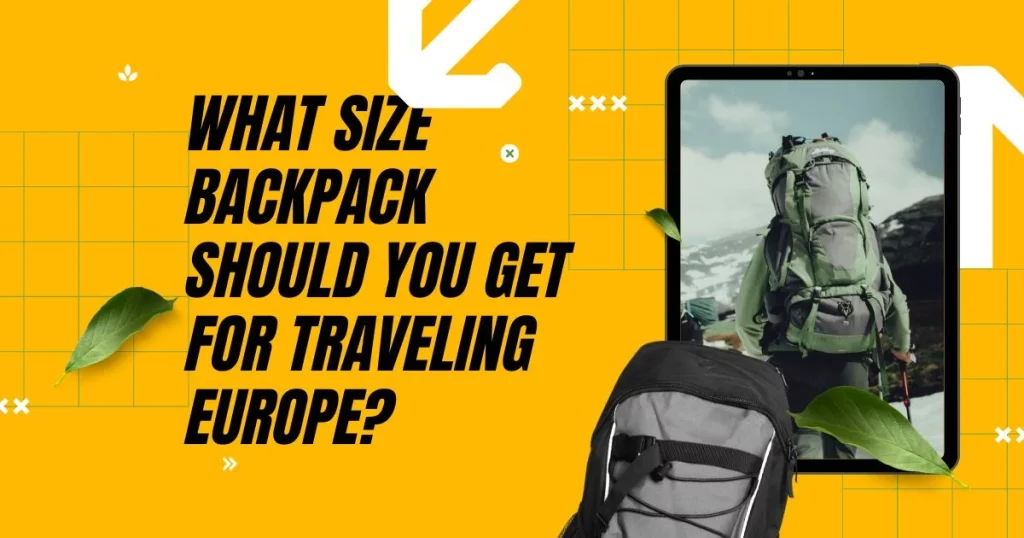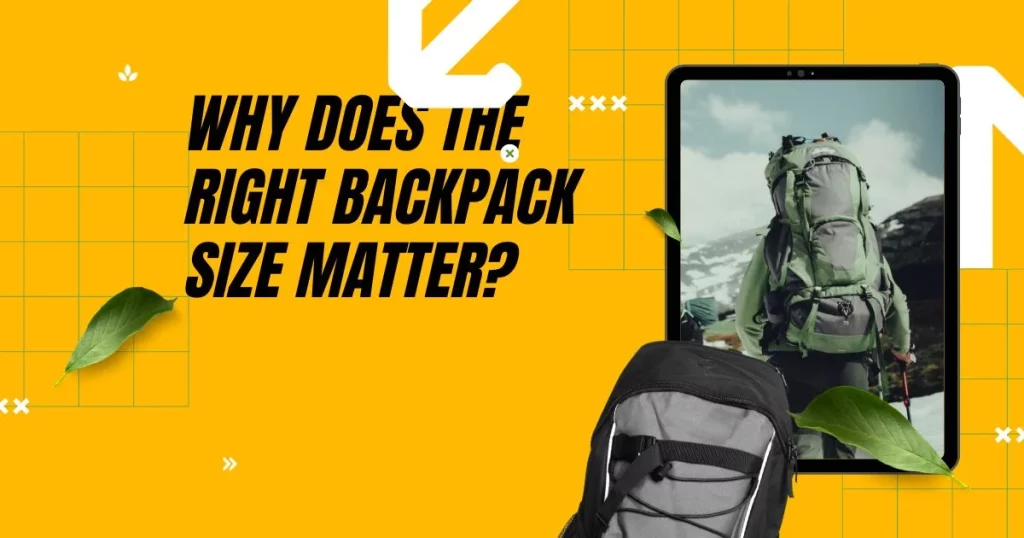What Size Backpack Should You Get for Traveling Europe?
- The capacity of bags typically varies between 30 litres (approximately 1,800 cubic inches) and over 100 litres (more than 6,000 cubic inches).
- I suggest opting for a backpack with a capacity ranging from 40 to 50 litres.
- It’s unnecessary to exceed 65 litres, although some prefer larger bags.

When planning a trip to Europe, choosing the right backpack is crucial. The size of your bag can make or break your trip, affecting your comfort, mobility, and overall experience. In this article, we’ll guide What Size Backpack Should You Get for Traveling Europe. Here is the complete guide on Is it Better to Travel with a Backpack or Suitcase.

Why Does the Right Backpack Size Matter?

When you travel, your backpack is your home away from home. It’s where you keep all your belongings and essentials, and having a backpack that fits you perfectly is essential. A backpack that’s too small can be uncomfortable and limit the amount of gear you can bring, while a backpack that’s too big can be cumbersome. Here is the guide on How to Lock a Backpack When Traveling: A Comprehensive Guide.
What to Consider Before Choosing a Backpack Size?
Before you choose a backpack size, consider the following factors:
Travel Style
Your travel style determines the type of backpack you need. You can opt for a giant pack if you’re staying in hotels and using taxis. However, a smaller bag is recommended if you’re backpacking and will be carrying your backpack around a lot.
Duration of Your Trip
The trip duration is also an essential factor to consider when choosing a backpack size. For shorter trips, a smaller backpack is usually sufficient, while for longer trips, you may need a giant pack to fit all your belongings.
Activities Planned
Consider the activities you have planned for your trip. Will you be doing a lot of hiking, or will you be spending most of your time in cities? A giant backpack may be necessary for outdoor activities to carry all your gear. We have reviewed on Top 5 Best Deuter Backpack for Travel.
Climate
The climate of your destination is another crucial factor to consider. If you’re traveling to a warm environment, you’ll need less bulky clothing and can opt for a smaller backpack. However, if you’re traveling to colder weather, you’ll need more clothing and gear, requiring a giant bag.
Types of Backpacks for Europe Travel
There are three types of backpacks to choose from for Europe travel:
Daypacks
Daypacks are small backpacks designed for day trips or short hikes. They usually have a capacity of 10-30 liters capacity and can fit essentials like water bottles, snacks, and jackets. Daypacks are perfect for travelers who don’t need to carry much and want to stay lightweight and mobile.
Carry-On Backpacks
Carry-on backpacks are larger backpacks designed to fit in the overhead compartment of planes. They usually have a 35-45 liters capacity and can provide a week’s clothing and essentials. Carry-on backpacks are ideal for travelers who want to avoid checked baggage fees and want to get their luggage at baggage claim immediately.
Checked Backpacks
Checked backpacks are larger backpacks designed for extended trips or outdoor adventures. They usually have a capacity of 50-80 liters capacity and can fit all your gear and clothing. Checked backpacks are perfect for travelers who need to carry a lot of equipment and are okay with checking their backpacks at the airport. We have reviewed on Top 11 Best Roll Top Travel Backpack in 2023.
Backpack Size Guide for Europe Travel
Daypack Size Guide
For daypacks, the ideal size is between 10-30 liters. This size is perfect for short hikes or day trips around cities. Daypacks are lightweight and easy to carry around, making them ideal for travelers who don’t need to have much.
Carry-On Backpack Size Guide
For carry-on backpacks, the ideal size is between 35-45 liters. This size is perfect for a week-long or shorter trip where you don’t need to carry a lot of gear. Carry-on backpacks fit in the overhead compartment of planes, avoiding checked baggage fees and saving time at the airport.
Checked Backpack Size Guide
For checked backpacks, the ideal size is between 50-80 liters. This size is perfect for extended trips or outdoor adventures where you must carry a lot of gear. Checked backpacks are larger and heavier, but they can fit all your clothing and equipment, making them ideal for longer trips.
How to Pack Your Backpack for Europe Travel?
Once you’ve chosen the perfect backpack size, it’s time to pack it for your Europe trip. Here are some tips to help you pack efficiently and comfortably:
Essential Features Of A Good Travel Backpack
Certainly, here are the essential features of a good travel backpack, written in English:
Build Quality
- A durable and well-constructed backpack is essential for withstanding the rigours of travel. Look for solid stitching, reinforced seams, and high-quality materials that endure various conditions.
Comfortable Shoulder Straps
- Padded and adjustable shoulder straps help evenly distribute the backpack’s weight across your shoulders. This prevents discomfort and strain, especially during long walks or hikes.
Padded Hip Belts
- A padded hip belt is crucial for transferring the backpack’s weight from your shoulders to your hips. This increases comfort and reduces strain on your back and shoulders.
Lightweight Backpack
- Opt for a backpack made from lightweight materials, as the pack itself adds to the overall weight you’ll be carrying. A lighter bag ensures you can pack more essentials without feeling weighed down.
Remember that the “best” backpack will also depend on your preferences and the type of travel you’re undertaking. Evaluating these features will help you find a bag that meets your needs and ensures a more enjoyable and comfortable travel experience.
WHAT SIZE IS THE BEST BACKPACK FOR EUROPE?
The ideal backpack size for travelling in Europe can vary depending on your preferences, travel style, and the duration of your trip. However, a popular and versatile size is around 40-50 litres. Here’s some guidance to help you decide:
- Duration of Trip: If you’re planning a short trip (1-2 weeks), a 40-50 litre backpack should be sufficient. For longer trips (3 weeks or more), you might need a slightly larger bag, around 50-60 litres.
- Packing Light: Remember that Europe is well-connected, and you can easily find laundry facilities, so packing light is recommended. Choose versatile clothing and consider doing laundry during your trip.
- Carry-On vs. Checked: If you plan to travel carry-on only, ensure that your backpack meets the size requirements of the airlines you’ll be flying with. A 40-50 litre backpack can often meet carry-on size restrictions.
- Comfort: Make sure the backpack fits comfortably on your shoulders and back. Look for padded straps and back support. Try different sizes and brands to find one that fits you well.
- Type of Travel: Your travel style matters. If you’re planning on hiking or camping, you might need extra space for gear. A smaller backpack might be more convenient if you’re staying in urban areas and using public transportation.
- Additional Features: Look for backpacks with compartments and pockets for better organization. Some bags also have detachable daypacks, which can be helpful for day trips.
- Weather Considerations: Depending on the time of year and the regions you’ll visit in Europe, you might need to pack bulkier clothing. Be prepared for varying weather conditions.
Remember that these are general guidelines, and your preferences might lead you to a slightly larger or smaller backpack. It’s essential to consider the items you plan to carry, your comfort, and the convenience of moving and storing your gear during your travels.
How big of a backpack do I need to travel to Europe?
The backpack size you need to travel in Europe depends on various factors, including your trip duration, travel style, and personal preferences. However, a standard recommendation is to use a backpack with around 40 to 50 litres capacity. This size should generally provide enough space to carry your essentials while remaining manageable and versatile for different travel situations.
Here’s a bit more detail to help you decide:
- Trip Duration: For a trip of 1-2 weeks, a 40-50 litre backpack should suffice. If you’re planning a longer journey, such as three weeks or more, consider a slightly larger backpack, around 50-60 litres.
- Packing Strategy: Europe is well-connected, making it relatively easy to find laundry facilities. Packing light is advisable, with versatile clothing that can be mixed and matched. Aim for a balance between having enough clothing options and not overloading your backpack.
- Travel Style: Consider the type of activities you’ll be engaging in. If you’re planning on hiking or camping, you might need additional space for gear. A smaller backpack could be more convenient for urban exploration and public transportation.
- Airlines and Transportation: If you plan to travel by air within Europe, check the carry-on size restrictions of the airlines you’ll use. A 40-50 litre backpack often fits these restrictions, allowing you to avoid checked baggage fees and save time at the airport.
- Comfort and Fit: A well-fitting backpack is crucial for your convenience. Look for padded shoulder straps, a hip belt, and back ventilation to reduce strain during extended wear.
- Additional Considerations: Look for backpacks with compartments and pockets for better organization. Some bags also come with detachable daypacks, which can be handy for day trips.
- Weather and Seasons: You might need to accommodate bulkier clothing for colder weather depending on when and where you’re travelling in Europe. Be prepared for various weather conditions.
Conclusion
In the above portion of my blog, i have write a complete guide on ” What Size Backpack Should You Get for Traveling Europe “The right backpack size is essential for a comfortable and stress-free Europe trip. Consider your travel style, trip duration, activities planned, and climate before choosing a backpack size. Opt for a daypack for short trips, a carry-on backpack for longer trips, and a checked backpack for extended or outdoor adventures. Once you’ve chosen the perfect backpack size, pack efficiently and comfortably to make the most of your Europe trip.
